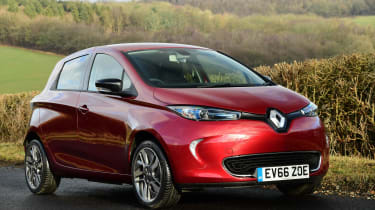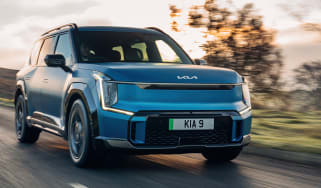Renault ZOE (2013-2019) review
The Renault ZOE looks great, has a long range and is golf-cart-easy to drive, making it a great first electric car
Pros
- Sprightly around town
- Long real-world driving range
- Well equipped
Cons
- A bit stodgy in corners
- Sluggish in Eco mode
- Most rivals charge quicker
| Car type | Official range | Wallbox charge time | Rapid charge time |
|---|---|---|---|
| Electric | 186 miles | 7hrs 25mins (0-100%, 7kW) | 1hr 38mins (10-80%, 22kW) |
The first-generation Renault ZOE is a small car of roughly the size of a Renault Clio, and it was designed to address two of the chief concerns people have about electric cars – price and range. The most up-to-date versions of 2018 could go as far as 186 miles, more than enough to satisfy most people's needs.
The catch to its most affordable price point was that you'd have to lease the ZOE’s battery, which cost around £60 per month or more depending on what mileage you wanted to do. The other option was to buy a ZOE complete with its battery, which caused the purchase price to jump significantly. But either way, the ZOE was one of the best value pure-electric family hatchbacks you could buy.
In late 2019, this ZOE was replaced with a heavily overhauled version, offering a longer range, more luxurious interior and no battery leasing option. You can read our review of that car here.
One niggle is that the ZOE – which came with the cables to charge from any Type 2 socket or three-pin domestic socket – doesn’t charge up very quickly at motorway rapid chargers: the ZOE R110 will take over an hour and a half to get to 80% full as the highest charge rate it will accept is 22kW.
On the road, the R110 ZOE will hit 62mph in 11.5 seconds, which can feel a bit slow on the motorway if you leave it in Eco mode (which restricts the car to 59mph) unless you stamp on the throttle. Taking it out of Eco and the ZOE becomes more than fast enough – although the range will deplete more quickly the more aggressively you drive. Ultimately, the little electric Renault is best when it’s away from main artery roads, humming around town or down country lanes.
Ride comfort is a little bouncy but generally good, and otherwise the ZOE is peachy to drive around town, costs buttons to run, and it charges up as quickly as any other car via a home charger.
It’s also well equipped. There were two trims when the car was on sale, with even the entry-level Dynamique Nav getting 16-inch alloys, a seven-inch touchscreen with sat nav, DAB, Bluetooth and Android Auto, automatic lights and wipers, rear parking sensors and power-folding mirrors. Apple CarPlay wasn't available, however.
The more expensive S Edition added a BOSE stereo and leather-finished seats (with the driver's seat getting lumbar adjustment), plus the option of upgrading to 17-inch 'Black Optemic' alloy wheels. A rear parking camera was included, too. Trim levels gained an ‘i’ on the ZOE models that include their batteries in the purchase price, becoming ‘i Dynamique Nav R110’, for instance.
No driver’s seat height adjustment was offered on either trim, so tall drivers should make sure they’re comfortable, as the ZOE has a reasonably high seating position.
Otherwise, everything in the ZOE is where you’d expect it to be in a conventional car and is easy to use. The dashboard generally looks smart, although a lot of the plastics around the interior lean more towards being durable than classy.

The 338-litre boot is actually bigger than a Clio’s, and will take a lightweight buggy or a big shop fairly easily. However, there’s a big drop down over the load lip and the rear seat back folds in one clunky piece to leave a step. More importantly, there’s nowhere to hide the cables away.
However, between the easy way it makes progress in town, fair comfort and low costs, the ZOE is one of the best electric cars for drivers who mostly do short-distance journeys.



